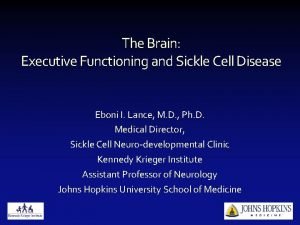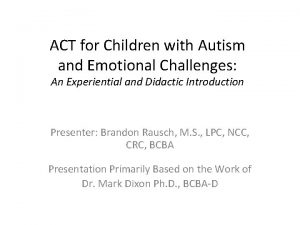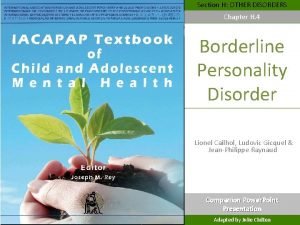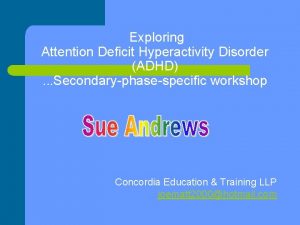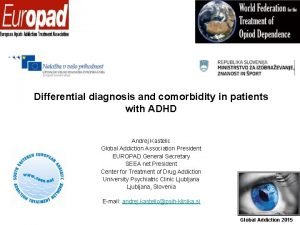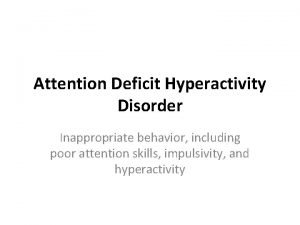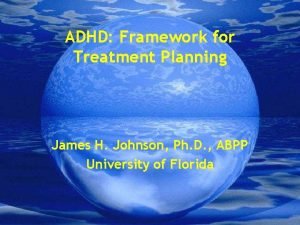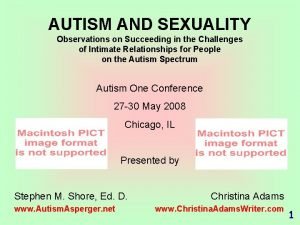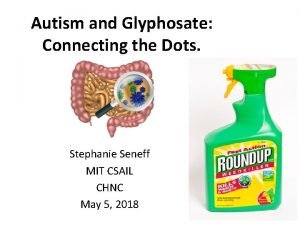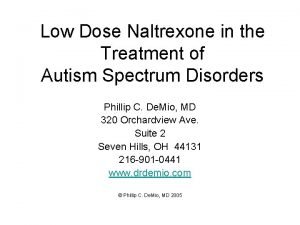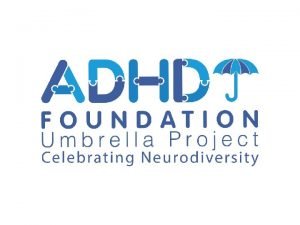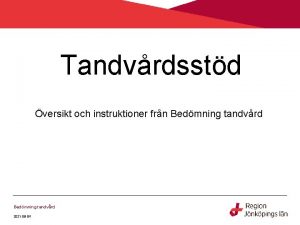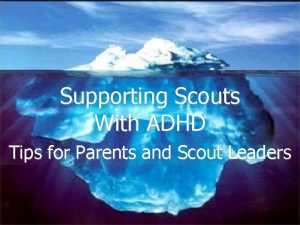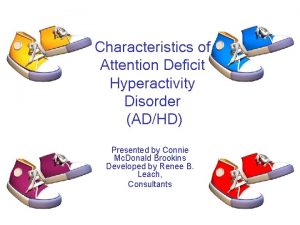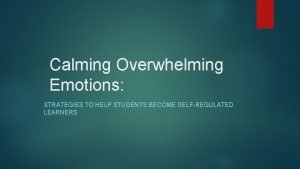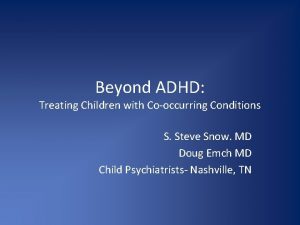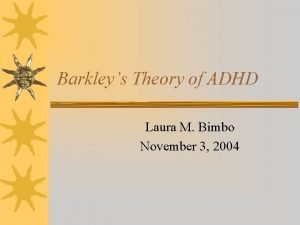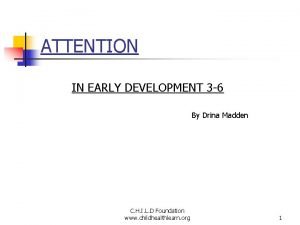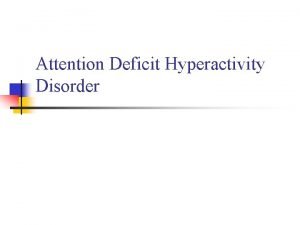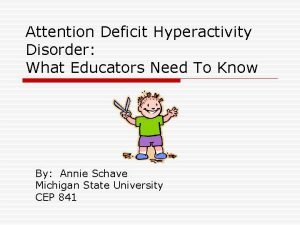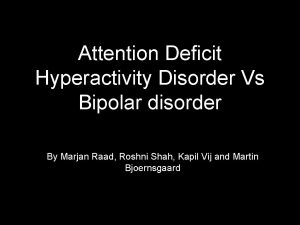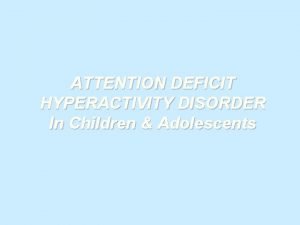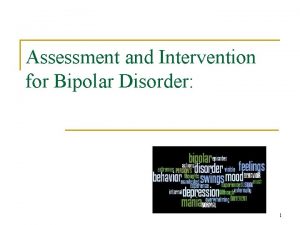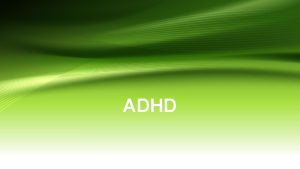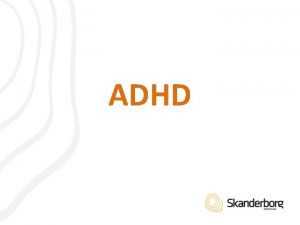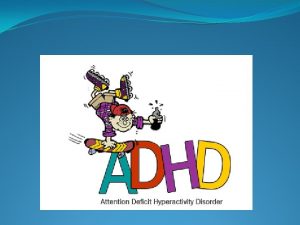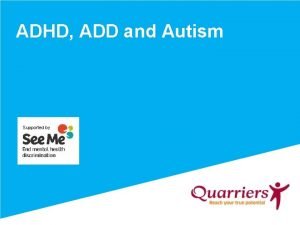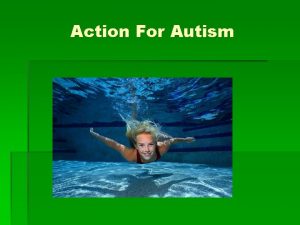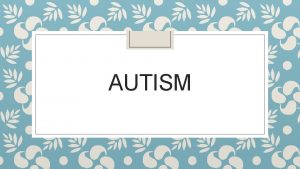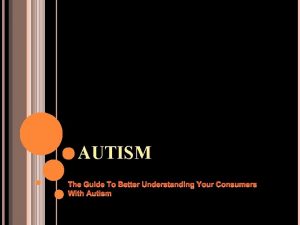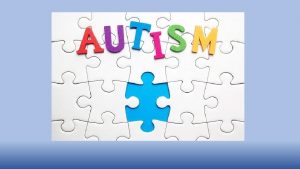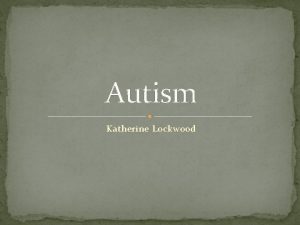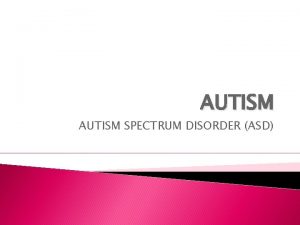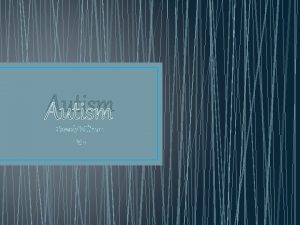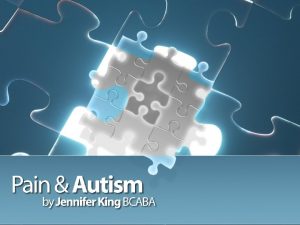SCADS OF CHILDREN WITH COEXISTING ADHD AUTISM AND

































- Slides: 33

“SCADS” OF CHILDREN WITH COEXISTING ADHD, AUTISM AND ANXIETY UNDERSTANDING AND TREATING COMPLICATED PROBLEMS WITH SELF-CONTROL AND ATTENTION DYSREGULATION DAN SHAPIRO, M. D. DRDAN@PARENTCHILDJOURNEY. COM WWW. PARENTCHILDJOURNEY. COM

UPCOMING PARENT CHILD JOURNEY PROGRAMS Parent Child Journey 10 Thurs. evenings, Washington, DC o St. Columba’s Episcopal Church o with Dan Shapiro, M. D. 10 Wed. evenings, Annapolis, MD o Bayside Pediatrics o with Sarah Wayland, Ph. D. 10 Tues. mornings in Potomac, MD o Geneva Day School o with Melissa Goldberg, Ph. D. All starting late Sept/ early Oct See Parent. Child. Journey. com All pay-what-you-can Parent Child Excursions with Dan Shapiro, M. D. • Tuesday, September 26 at 7: 30 PM • Sexuality, Gender & Developmental Differences • Auburn School in Silver Spring • Tuesday, October 17, 2017, 7: 30 PM • Helping Your Child Learn to Manage Anxiety • St. Andrew’s Episcopal School • Tuesday, November 14 at 7: 30 PM • Helping Your Child Experience Social Success • St. Andrew’s Episcopal School

THIS TALK IS FROM MY FORTHCOMING BOOK PARENT CHILD EXCURSIONS: SPECIAL TOPICS IN RAISING YOUR CHALLENGING CHILD (due for release 2018)

THE MYTH OF DAEDALUS AND ICARUS

WHETHER PAUSING TOO MUCH OR PAUSING TOO LITTLE: FIND BALANCE

TWO BRAIN SYSTEMS: EXCITATORY AND INHIBITORY TOO UNINHIBITED TOO INHIBITED • Simon didn’t say, “Raise your • Simon says, “Raise your hand. ” • Errors of omission hand. ” • Errors of commission

COEXISTING CONDITIONS • DSM 5 (May 2013): autism and adhd commonly co-occur • ADHD often co-occurs with autism and/ or anxiety • Co-occurrence complicates assessment and treatment

THE SELF-CONTROL AND ATTENTION DYSREGULATION SPECTRUM (SCADS) ADHD AUTISM AND ANXIETY under-inhibition over-inhibition distractibility, poor focus perseveration , hyperfocus brakes too loose brakes too tight gears shift too easily stuck in one gear impulsive, prefer novelty inflexible, prefer repetition and ritual leap before looking, dangerous step back, avoid , shut down, safe too much in the moment, here and now too much in the past and/ or future focus on too many things instead of focus on one thing, exclusively

SCADS FLIPPING IN CHILDREN WITH MIXED PROFILES • Task, situation, and setting specific differences • • • Walter Mischell, The Marshmallow Test, and the Myth of Personality Attention dysregulation; not across-the-board attention deficit Inconsistency vs. inability • For example: • “more ADHD” (impulsive and distractible) for auditory-verbal situations • “more Autistic” (stuck and perseverative) for visual-motor activities

TREATMENT OF SCADS ADHD • Use your brakes, slow down • Stop and think more • Don’t just live in the moment • Consider past and future • Be more cautious • Narrow your comfort zone • “Be more autistic/ anxious” AUTISM/ ANXIETY • Take your foot off the brake, let go • Don’t stop and think so much • Don’t worry about past / future • Live more in the moment • Relax • Expand your comfort zone • “Be more adhd”

MEDICATION MANAGEMENT OF SCADS • No effective medication for the core symptoms of Autism • social disability • repetitive, restricted, and ritualized thoughts / behavior • But very effective meds for ADHD and Anxiety

WHEN ADHD, AUTISM AND ANXIETY COEXIST NARROW THERAPEUTIC WINDOW • Risk: greater predisposition to side effects • side effects kick in at relatively low doses • too often, before benefits • failed trials or only partial response • Realistic goal: find the sweet spot between too much and too little inhibition

MEDICATION MANAGEMENT OF SCADS TUNING: FINDING THE SWEET SPOT, GOLDEN MEAN For ADHD • just enough stimulant (methylphenidates or dextroamphetamines) to fix impulsivity and distractibility (brakes too loose) • but not so much that you amplify Autism or Anxiety (brakes too tight). • common side effects of stimulants: irritability, inflexibility, social withdrawal For Anxiety • just enough SSRI (selective serotonin re-uptake inhibitor) to fix rigidity and distress (brakes too tight) • but not amplify ADHD (brakes too loose) • common side effects of SSRIs : disinhibition and overactivation

COMPLICATED DOES NOT MEAN IMPOSSIBLE • Meds can be a huge help for many • Find a doc with experience treating these coexisting conditions • Set up a sufficiently nuanced treatment trial • Use a team of educated observers

0=no problem TREATMENT TRIAL 1=little problem 2=medium problem 3=big problem for: Targets Possible Side Effects Date baseline date

IF SIDE EFFECTS • Do not try to treat the side effects of one medicine with the other • • Treating adhd induced anxious perseveration with SSRI Treating SSRI induced overactivation with stimulant • Instead, try to fine-tune the dose • • • Find the minimum dose that’s sufficiently effective or The maximum dose that avoids side effects Then, decide if that’s good enough (swing for singles, not homeruns) • If not good enough, go to secondary meds • • Second stimulant or non-stimulant (guanfacine, clonidine, atomoxetine) Second SSRI or non-SSRI (duloxetine or buspirone) • Think about non-pharm management opportunities

CASE DISCUSSION: JIMMY 8 YEAR OLD WITH COEXISTING ADHD, ANXIETY AND AUTISM 1. Failed fluoxetine and fluvoxamine trials (overactivation before benefit) 2. 3. 4. Quillivant max tolerated dose: 25% improvement 5. 6. Buspirone max tolerated dose: 50% less anxious Guanfacine max tolerated dose: 25% additional improvement Failed trial off Quillivant (combination better than either ADHD med alone) Combine pharm and non-pharm management

SCADS AND NON-PHARM MANAGEMENT • Especially with more complicated profiles, be realistic about meds • • There is always a limit to what medication can do Medication is never the whole answer Medication should always be part of a comprehensive management plan Need non-pharm strategies too • But, non-pharmacologic interventions are also more complicated when adhd, anxiety and autism coexist • So, how to apply SCADS principles of pharm management – “find the golden mean” - to non-pharm management?

“Human freedom involves our capacity to pause between the stimulus and response and, in that pause, to choose the one response toward which we wish to throw our weight. ” - Rollo May, The Courage to Create

PAUSING JUST RIGHT CBT BREAKDOWN POINTS IN SCADS CBT “STEPS” BREAKDOWN POINTS • Stop and Say • Think about all possible solutions • Examine each one • Pick the best one • See how it works Pausing in ADHD • stop and think, slow down and focus Pausing in Autism and Anxiety • loosen up, consider alternative solutions and perspectives

THE SCADS MIDDLE GROUND IN CBT STEPS “Lose a point” if you… 1. Go too fast or go too slow 2. Skip a step or stick to a step 3. Choose the wrong answer Modified from Phillip Kendall, Cognitive-Behavioral Therapy for Impulsive Children

PRACTICE ROUND START WITH 10 POINTS STEPS • Stop and Say • Think about all possible solutions • Examine each one • Pick the best one • See how it works LOSE A POINT IF YOU… 1. Go too fast or go too slow 2. Skip a step or stick to a step 3. Choose the wrong answer

THE GOLDEN MEAN IN EXPOSURE THERAPY • Staging for success • finding the Golden Mean in gradual/ incremental exposure (ladders) • consolidate gains at each level; don’t raise the bar too fast • finding the “just right” balance between remediation and accommodation; intervention and acceptance • Goodness-of-fit between child and adult helpers • SCADS of parents, therapists, and teachers • exposure therapy targets the adults, the family system, the school, sometimes even the community; not just the child • It takes a village • practice in natural settings is crucial to progress • share goals and strategies across settings • combine CBT, medication, and possibly otherapies

REPRISE: THE MYTH OF DAEDALUS AND ICARUS WHEN CBT FAILS PARALLEL EXPOSURE THERAPY Finding the golden mean between parent and child

PARALLEL EXPOSURE THERAPY • Parents have anxieties too • Inherited: shared anxiety genes • Acquired: anxiety about their child’s anxiety • Failure to do homework • not necessarily parent “non-compliance” • may be parent’s anxiety about child’s anxiety

BUT STANDARD CBT FOR ANXIETY FOCUSES ONLY ON THE CHILD • Scared? • Thinking about what? • Other things I can do or think to help myself relax • Pat myself on the back for helping myself calm down BUT HOW WOULD THE PARENT ANSWER THESE

A CHANGE OF ATTITUDE FOR PARENT AND CHILD • Externalize the anxiety • You control it • It stops controlling you

HOW WILL I - CHILD AND PARENT - CHANGE IT? • Realistic thinking • Relaxation • Exposure

FEAR THERMOMETER FOR PARENT AND CHILD 1 2 3 4 5 6 7 8 9 10 no I’m a maybe I I don’t really NO problem little can resist think so hard! WAY! uneasy but I’m not sure

ANXIETY SYMPTOMS FOR PARENT AND CHILD Rank Symptom 1 2 3 4 5 6 7 8 9 10 Temperature (1 -10) Target Date

GRADUATED EXPOSURE FOR PARENT AND CHILD • Start with the smallest fears on BOTH child’s AND PARENT’S rating scale • “Low hanging fruit” • Slowly increase the degree of difficulty • Finally, the child AND PARENT challenge THEIR worst fears

FACING OUR FEARS: STEP-BY -STEP Final goal: Goal #6 Goal #5: Goal #4: Goal #3: Goal #2: Goal #1:

UPCOMING PARENT CHILD JOURNEY PROGRAMS Parent Child Journey 10 Thurs. evenings, Washington, DC o St. Columba’s Episcopal Church o with Dan Shapiro, M. D. 10 Wed. evenings, Annapolis, MD o Bayside Pediatrics o with Sarah Wayland, Ph. D. 10 Tues. mornings in Potomac, MD o Geneva Day School o with Melissa Goldberg, Ph. D. All starting late Sept/ early Oct See Parent. Child. Journey. com All pay-what-you-can Parent Child Excursions With Dan Shapiro, M. D. • Tuesday, September 26 at 7: 30 PM • Sexuality, Gender & Developmental Differences • Auburn School in Silver Spring • Tuesday, October 17, 2017, 7: 30 PM • Helping Your Child Learn to Manage Anxiety • St. Andrew’s Episcopal School • Tuesday, November 14 at 7: 30 PM • Helping Your Child Experience Social Success • St. Andrew’s Episcopal School
 Autism spectrum disorder adhd
Autism spectrum disorder adhd Self as context
Self as context Personality disorder types
Personality disorder types Caffeine and adhd
Caffeine and adhd Adhd or borderline personality disorder
Adhd or borderline personality disorder Differnce between add and adhd
Differnce between add and adhd Adhd treatment plan example
Adhd treatment plan example Puberty and autism spectrum disorders
Puberty and autism spectrum disorders Chess and bridge
Chess and bridge Steven 90 day fiancé autistic
Steven 90 day fiancé autistic Glyphosate and autism
Glyphosate and autism Ucla autism center
Ucla autism center Naltrexone and autism
Naltrexone and autism Neurodiversity umbrella
Neurodiversity umbrella Casus adhd
Casus adhd F-tandvård adhd
F-tandvård adhd Adhd iceberg
Adhd iceberg Tierney peprah
Tierney peprah Female adhd
Female adhd Que es adha
Que es adha What is adhd means
What is adhd means Disassociating adhd
Disassociating adhd The bipolar spectrum
The bipolar spectrum Clonidine for adhd
Clonidine for adhd Barkley's theory of adhd
Barkley's theory of adhd Adhd in 3 year old
Adhd in 3 year old Adhd combined type
Adhd combined type What causes adhd
What causes adhd What causes adhd
What causes adhd Adhd vs bipolar
Adhd vs bipolar What cause adhd
What cause adhd Is adhd a neurological disorder
Is adhd a neurological disorder Hypomania adhd
Hypomania adhd Ciri adhd
Ciri adhd
